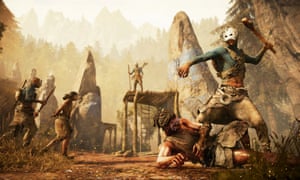Set in the Stone Age, this game is nothing like the previous instalments of the franchise, lacking modern weaponry and an arch-villain

Finding a game disappointing because of its similarity to last year’s instalment is one of the great complaints levelled at the modern industry and its love of annual franchises. Far Cry 4, for example, was certainly accused of being too much like Far Cry 3, and the more you play Primal, the more it feels like an elaborate attempt to challenge all the assumptions around sequels and spin-offs.
This time around, Ubisoft Montreal has certainly created a startlingly different Far Cry game, simply by setting it in the Stone Age – 10,000BC, to be precise. Unlike its forebears then, you can’t describe it as an open-world first-person shooter – it’s still first-person and open-world, but all guns, vehicles, explosives and gadgets have been summarily ripped out.
You play as Takkar, an unapologetic alpha male in the otherwise peaceful Wenja tribe. Your role is to build up your nascent village, established in a province called Oros, by helping out the scattered local Wenja tribespeople. Early on, he rescues Sayla, a hunter and warrior who identifies missing members of the clan for you to track.
From these quests Takkar assimilates an incredible array of skills. Tensay, the shaman, is perhaps his most important guru: he makes Takkar drink a foul brew which induces distinctly psychedelic visions, after which he learns how to tame animals. He acquires a pet owl, and has the ability to see through its eyes, which makes it a handy scout as it can tag enemies – and even, when upgraded, attack them. But more importantly, Takkar can tame animals that will accompany him on his peregrinations and take down enemies. As you build up experience points and progress through Takkar’s skills-tree, he becomes able to tame (and even, in some instances, ride) the likes of sabretooth tigers and giant bears. Big set-piece hunt missions let you tame extra-savage beasts, which prove more or less essential allies when the story reaches its later, more frenetic stages.
The narrative also takes in Wenja’s interaction with two other local tribes – the warlike, basic Udam from the mountainous north of Oros and the more sophisticated Izila, masters of fire, who occupy the marshy south. Udam attacks feature from the beginning of Primal, and the responsibility for fighting back against both tribes, and ultimately making them fear the Wenja, falls squarely onto Takkar’s shoulders. That process proves surprisingly thought-provoking: has tribal conflict always been hard-wired into mankind and, if so, what did it take for tribes to start working together for the greater good?
You can pick all manner of allegory out of Far Cry Primal’s story but, when viewed in pure gaming terms, it fails to be as satisfying as the storylines running through previous iterations of the franchise. Takkar does get to meet some great characters – Batari, the female leader of the Izila, manages to be both homicidal and alluring, and many of the Wenja characters have hilarious eccentricities, such as Sayla’s penchant for collecting the ears of dead Udam – but unlike previous Far Cry games, there’s no arch-villain providing a focal point and, ultimately, the story fizzles out in a vaguely unsatisfying manner (although it sets itself up well for extension via downloadable content).
Far Cry Primal is, however, a huge, sprawling source of great gaming joy, and wisely, Ubisoft resisted the temptation to shoe-horn in any dubious multiplayer modes. Any worries about the lack of modern weaponry are quickly banished by the array of available arms. Takkar has a club, a spear and a bow, all of which are available in different iterations, can be set on fire and are fully upgradable. He gets the Stone Age equivalent of grenades, in the form of bags of bees that leave enemies flailing or bags of rotten matter that induce them to lay into each other. There’s one gadget – a grapple – which proves invaluable when negotiating mountainous territory, and provides a centrepiece for a few puzzle-solving side missions.
Skills which initially seem superfluous become vital later on in the game, when Takkar has to take on vast hordes of enemies (and the odd boss) with just his trusty beast at hand. The ability to craft bunches of replacement spears and arrows on the fly, and to heal Takkar while running, are especially pivotal. The gameplay is pleasantly varied – there are plenty of sequences in which Takkar has to employ stealth, or use his hunter’s vision to track prey and effectively operate as a Stone Age detective.

There’s much satisfaction to be had from taking out a succession of onrushing enemies with spear headshots – yet few games offer more opportunities to just amble about the game-world, hunting, exploring, collecting resources and dealing with whatever random events come your way. The game-world itself is so beautifully realised that it almost becomes a character in its own right: you learn, for example, how to read the terrain and take detours in order to reach seemingly inaccessible areas. Oros may be savage, but it’s a glorious and cathartic place to visit.
Like the similarly experimental Far Cry 3: Blood Dragon, Primal takes a torch to the established Far Cry template, yet it still feels every inch a Far Cry game. The graphics, controls, hunting, map and resource-collection are all recognisable – to such a striking extent that it makes you wonder what it would be like to play through an old version of Far Cry, using just the bow and ignoring all vehicles. Whether by accident, design or an emotive response to criticism of Far Cry 4, Ubisoft, via Primal, has given the franchise a huge new shot of vitality and freshness.
[Source:- Gurdian]








